



Government of India committed to Safeguard IP content: Commerce Secretary
Government of India is committed to safeguard against infringement of originality and creativity of the makers to give a boost to services exports.
Services Exports Promotion Council (SEPC), set-up by the Ministry of Commerce & Industry, has brought out the India Intellectual Property (IP) Guide at Cannes in MIPCOM 2019, being held from 14-17, October 2019, for the Media and Entertainment (M&E) industry. One of the key objectives at SEPC is to facilitate service exporters of India and handhold medium and small enterprises to expand their global footprint and to present IPs from India to the buyers and distributors from across the globe.
About IPR: IP is protected in law by, for example, patents, copyright and trademarks, which enable people to earn recognition or financial benefit from what they invent or create.
Trademark: A trademark is a sign capable of distinguishing the goods or services of one enterprise from those of other enterprises.
Patent: A patent is an exclusive right granted for an invention, which is a product or a process that provides, in general, a new way of doing something, or offers a new technical solution to a problem.
Copyright: Copyright (or author’s right) is a legal term used to describe the rights that creators have over their literary and artistic works. Works covered by copyright range from books, music, paintings, sculpture, and films, to computer programs, databases, advertisements, maps, and technical drawings.
National Intellectual Property Rights (IPR) Policy 2016 was adopted on 12.5.2016 as a vision document to guide future development of IPRs in the country. It is comprehensive and holistic, and cannot be said to lack specifics.
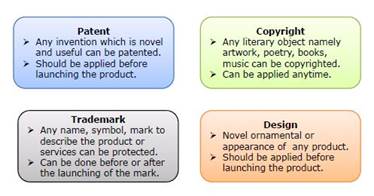
- IPR Awareness: Outreach and Promotion- Generation of IPRs: To create public awareness about the economic, social and cultural benefits of IPRs among all sections of society.
- Generation of IPRs- To stimulate the generation of IPRs.
- Legal and Legislative Framework: To have strong and effective IPR laws, which balance the interests of rights owners with larger public interest.
- Administration and Management: To modernize and strengthen service-oriented IPR administration;
- Commercialization of IPR: Get value for IPRs through commercialization
- Enforcement and Adjudication: To strengthen the enforcement and adjudicatory mechanisms for combating IPR infringement.
- Human Capital Development: To strengthen and expand human resources, institutions and capacities for teaching, training, research and skill building in IPRs.
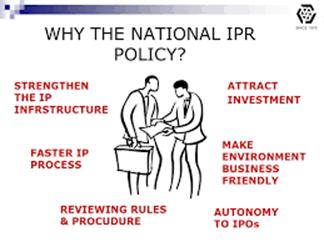
- Transfer of Copyright and Semiconductor Integrated Circuits Layout-Design to Department of Industrial Policy and Promotion have been done.
- Augmentation of manpower, including recruitment of 458 Patent Examiners, has been done.
- Patent Rules, 2003 has been amended to streamline processes and make them more users friendly.
- IPR Awareness programs have been conducted in over 200 academic institutions, including rural schools through satellite communication, and for industry, police, customs and judiciary.
- Content on IPRs has been included in the NCERT curriculum of Commerce stream.
- A IPR Enforcement Toolkit have been prepared to assist police officials in dealing with IP crimes, in particular, Trademark counterfeiting and Copyright piracy.
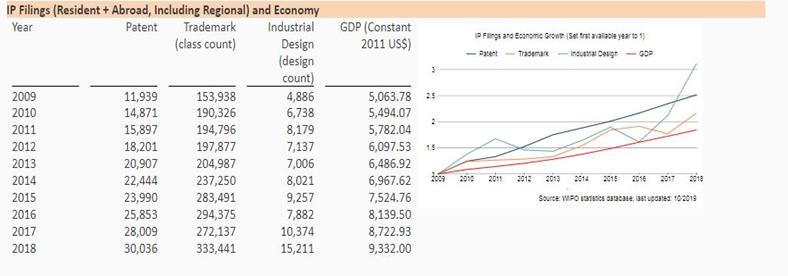
- Developed countries accuse India of following protectionist policy while granting patent especially in pharmaceuticals and food sector.
- Section 3(d) of patent act, which does not allow ever greening of the patents, is highly criticized by innovative companies.
- Provision of compulsory license, which allows government to force company to mass-produce a product in case of emergency irrespective of who got the patent.
- Provision of drug price control order does not let innovative product to reap the windfall gains. Recent notification of stent price control was widely criticized.
- Traditional knowledge digital library, which does not let multinationals companies to benefit from traditional knowledge, is also criticized.
- It encourages and safe guard intellectual and artistic creation.
- It encourages investment in research and development efforts.
- It provides the consumers with the result of creations and invention.
- It enables the dissemination of new ideas and technologies quickly and widely.
- IPR has encouraged monopolies; many take over’s have been motivated by access to an IPR.
- It may adversely affect biological diversity and ecological balance.
- Adversely affect the livelihood of the poor in developing countries.
- Can IPR stop us from using our own traditional knowledge?
- Will our lives be governed by trans-nationals?
- What will happen to local workmen?
- Will there be piracy of National Biodiversity?
- Will local initiatives be negatively impacted and stunt local development?
Source: The pib
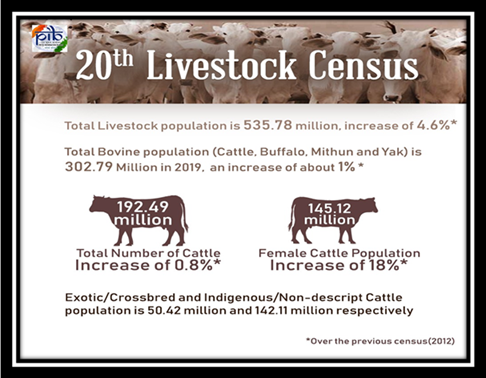
- Conducted every five years, livestock census is crucial to measure the increase in population of animals that play a role in the economy.
- As part of the census, enumerators go door-to-door and count the livestock in each household.
- The 20th census will be the first time that productivity of the animals, as well breed-wise details of livestock, will be recorded.
- Numerators are collecting details like those that a day’s productivity of animals — cattle, buffalo, poultry etc — and this figure will help understand the levels of production of commodities like milk, eggs etc.
- The census will record details of 12 different species of animals.
Source: The Pib
- Eat Right India movement is a crucial trigger for the much needed social and behavioural change.
- This campaign along with the ‘Fit India' Movement' can achieve huge success if the right strategy is adopted and efforts are made to reach out to every section of the society.
- People should adopt Gandhiji’s messages of eating less, eating safe and healthy food, and reduce wastage of food while developing the habit of sharing surplus food.
- The Eat Right Movement built on two broad pillars of 'Eat Healthy' and 'Eat Safe', aims to engage, excite and enable citizens to improve their health and well-being.
- Led by FSSAI, it is a collective effort to make both the demand and supply-side interventions through the engagement of key stakeholders.
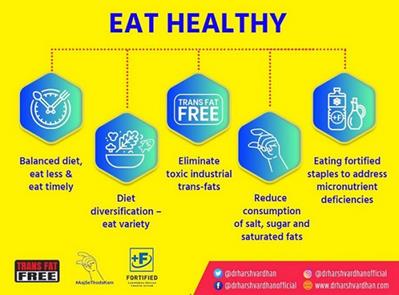
- The ‘Food Safety Mitra (FSM)’ scheme will support small and medium scale food businesses to comply with the food safety laws and facilitate licensing and registration, hygiene ratings and training.
- Apart from strengthening food safety, this scheme would also create new employment opportunities for youth, particularly with food and nutrition background.
- He FSMs would undergo training and certification by FSSAI to do their work and get paid by food businesses for their services.
- The ‘Eat Right Jacket’ launched today will be used by the field staff.
- This jacket has a smart design to hold tech devices like tablets/smart phone, a QR code and RFID tag for identification and tracking.
- Apart from providing safety to field staff on duty, this would bring in efficiency, professionalism and transparency in food safety administration and bring in a sense of ownership & visibility of FSOs.
Source: PIB
The latest Global Hunger Index (GHI) has ranked India a lowly 102 among the 117 countries it has mapped.
- The GHI has been brought out almost every year by Welthungerhilfe (lately in partnerships with Concern Worldwide) since 2000
- The GHI slots countries on a scale ranging from “low” hunger to “moderate”, “serious”, “alarming”, and “extremely alarming”.
- India is one of the 47 countries that have “serious” levels of hunger.
- A low score gets a country a higher ranking and implies a better performance.
- The reason for mapping hunger is to ensure that the world achieves “Zero Hunger by 2030” — one of the Sustainable Development Goals laid out by the United Nations.
- It is for this reason that GHI scores are not calculated for certain high-income countries.
- In a formal sense, GHI is calculated by mapping the level of calorie intake.
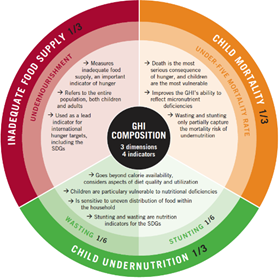
- Undernourishment (which reflects inadequate food availability): calculated by the share of the population that is undernourished (that is, whose caloric intake is insufficient).
- Child Wasting (which reflects acute undernutrition): calculated by the share of children under the age of five who are wasted (that is, those who have low weight for their height).
- Child Stunting (which reflects chronic undernutrition): calculated by the share of children under the age of five who are stunted (that is, those who have low height for their age).
- Child Mortality (which reflects both inadequate nutrition and unhealthy environment): calculated by the mortality rate of children under the age of five (in part, a reflection of the fatal mix of inadequate nutrition.
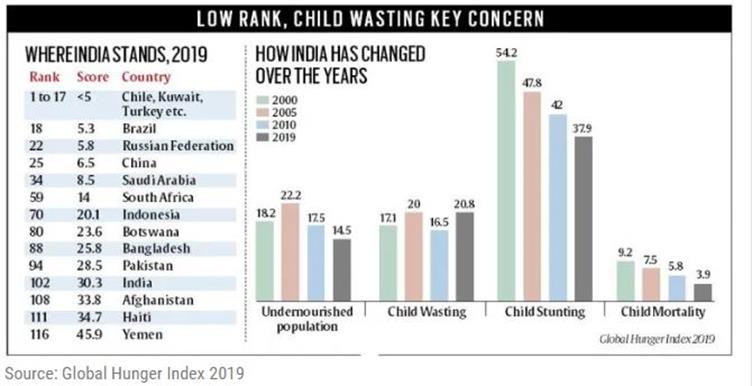
- Among the BRICS grouping, India is ranked the worst, with China at 25 and a score of just 6.5.
- Within South Asia, too, India is behind every other country. Sri Lanka, Nepal, Bangladesh and Pakistan (in that order) are all ahead of India.
- The pace of India’s improvement has been relatively slow.
- Notwithstanding the broader improvements, there is one category — Child Wasting, that is, children with low weight for their age — where India has worsened.
- In India, just 9.6 percent of all children between 6 and 23 months of age are fed a minimum acceptable diet.
Reference: https://indianexpress.com/article/explained/global-hunger-index-why-india-trails-6072465/
UNICEF released its State of the World’s Children report for 2019.
- One in three children under the age of five years — around 200 million children worldwide — are either undernourished or overweight.
- In India, every second child is affected by some form of malnutrition.
- The report said 35% of Indian children suffer from stunting due to lack of nutrition, 17% suffer from wasting, 33% are underweight and 2% are overweight.
- Among countries in South Asia, India fares the worst (54%) on prevalence of children under five who are either stunted, wasted or overweight.
- Poor brain development
- Weak learning
- Low immunity
- Increased infections
- Increased Mortality
- Indian children are being diagnosed with adult diseases such as hypertension, chronic kidney disease and diabetes.

- Our diet has dramatically changed because of both globalisation and urbanisation. India moved away from seasonal food as well as traditional food one hand and consumption of processed food has increased on the other.
- Poor uneducated women do not focus on children nutrition.
- Poor sanitations, lack of access to good quality food, lack of access to mineral drinking water are biggest reasons behind it.
- Birthing child in lower age, poor nutritional status of pregnant women and lack of adequate gap between two children are other reasons.
- Low per capita income, higher food inflation specially fruit inflation, monodiet (having rice and lentils only) further aggravates the malnutrition’s.
- Poor implementation of the Policies like ICDS (Integrated Child development scheme), corruption in implementation of Mid-day meal scheme, lack of convergence between different ministries is other policy related causes.
- Poor fund utilization: Many States have only utilized 16% of their allotted funds in National Nutrition Mission.
- Government has launched a National Nutrition Mission to deal with malnutrition.
- It set targets to reduce stunting, under-nutrition, anaemia among young children, women and adolescent girls and reduce lowbirth weight by 2%, 2 2%, 3% and 2% per annum respectively.
- It focuses on intense monitoring and Convergence Action Plan right up to grass root level.
- It will also create synergy, issue alerts for timely action, ensure better monitoring, and encourage States/UTs to perform.
- It will also incentivize Anganwadi Workers (AWWs) for using IT based tools.
- Other Direct Targeted interventions: 1) Integrated Child Development Services (ICDS) 2) National Health Mission (NHM) 3) Mid-Day Meal Scheme 4) Rajiv Gandhi Schemes for Empowerment of Adolescent Girls (RGSEAG) or SABLA, 5) Indira Gandhi Matritva Sahyog Yojana (IGMSY).
- Focus on increasing breast-feeding through programs like MAA (Mothers Absolute affection).
- Indirect approach like Swachh Bharat Abhiyan, Jal Shakti also focusses on Malnutrition.
NSA Doval mentioned former British PM while discussing role of media in fight against terrorism.
- Media is a very important organ to fight terrorism.
- If terrorists take action and the media is quiet, the terrorism will end.
- Terrorists terrorise people. If media does not write, nobody would come to know.
- The hijacker and the terrorist thrive on publicity: without it, their activities and their influence are sharply curtailed.
- They see how that coverage creates a natural wave of sympathy for the victims and pressure to end their plight no matter what the consequence.

© 2025 iasgyan. All right reserved